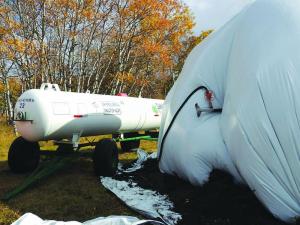How To Turn Straw, Chaff Into High-Quality Feed
 ✖  |
You can boost the nutritional value of low-quality feedstuffs by injecting them with a little anhydrous ammonia instead of buying high-priced hay. At an on-farm workshop last fall, Manitoba researchers reminded a group of farmers that adding anhydrous to straw, chaff and other crop materials was a common practice 20 to 30 years ago.
“Ammoniation is a good option in a year when there is a shortage of forage or when it’s expensive, like it was this past winter,” says Shawn Cabak, Manitoba Agriculture and Resource Board. “Past studies have shown you can double the protein, increase digestibility by 10 to 30 percent, and improve intake by 15 to 20 percent. Producers who have tried it say the cattle like the taste.”
After taking samples for before and after comparison, Cabak and Tim Clarke, a fellow forage and livestock specialist, injected ammonia into 5 types of low-quality roughages. Bales included wheat straw, wild hay, canola chaff, wheat chaff and mature alfalfa grass hay. The forages were stacked in a 6-bale pyramid of 65 bales.
They added ammonia at 3.1 percent of dry matter sealed under 5 mil plastic at a cost of 1.6 cents per pound of dry matter. With high-quality hay at 8 to 10 cents per pound and straw at 2 1/2 cents per pound, Cabak suggests the ammoniated forage is a good deal.
“It is a really good option when there is a shortage of hay,” says Cabak.
Application costs are reasonable as well. Cabak and Clarke used drill stem pipe with a threaded end to inject the ammonia. They used the tank meter to judge the quantity injected.
“We covered the bales with plastic and sealed the plastic at the ground with dirt to prevent leakage,” says Cabak. “We put the pipe in the middle of the stack and injected the ammonia. The plastic billowed out, and a little that escaped could be smelled.”
Cabak stresses that safety precautions associated with ammonia need to be followed. He suggests doing injection up wind of people. “The safety factor is our biggest concern,” says Cabak. “Once the ammonia is shut off, the plastic drops, the pipe can be pulled out and the plastic sealed. When the bales are uncovered weeks later, uncover up wind for safety as there will be some release of ammonia.”
He adds that corn stover bales are especially well suited to injection. “If you double corn stover protein and energy, it would be close to meeting a lactating cow’s needs.”
Contact: FARM SHOW Followup Shawn Cabak, 25 Tupper St. N, Portage la Prairie, Man. Canada R1N 3K1 (ph 204 239-3353; Shawn.Cabak@gov.mb.ca).

Click here to download page story appeared in.
Click here to read entire issue
How To Turn Straw Chaff Into High-Quality Feed LIVESTOCK Feeding Equipment You can boost the nutritional value of low-quality feedstuffs by injecting them with a little anhydrous ammonia instead of buying high-priced hay At an on-farm workshop last fall Manitoba researchers reminded a group of farmers that adding anhydrous to straw chaff and other crop materials was a common practice 20 to 30 years ago “Ammoniation is a good option in a year when there is a shortage of forage or when it’s expensive like it was this past winter ” says Shawn Cabak Manitoba Agriculture and Resource Board “Past studies have shown you can double the protein increase digestibility by 10 to 30 percent and improve intake by 15 to 20 percent Producers who have tried it say the cattle like the taste ” After taking samples for before and after comparison Cabak and Tim Clarke a fellow forage and livestock specialist injected ammonia into 5 types of low-quality roughages Bales included wheat straw wild hay canola chaff wheat chaff and mature alfalfa grass hay The forages were stacked in a 6-bale pyramid of 65 bales They added ammonia at 3 1 percent of dry matter sealed under 5 mil plastic at a cost of 1 6 cents per pound of dry matter With high-quality hay at 8 to 10 cents per pound and straw at 2 1/2 cents per pound Cabak suggests the ammoniated forage is a good deal “It is a really good option when there is a shortage of hay ” says Cabak Application costs are reasonable as well Cabak and Clarke used drill stem pipe with a threaded end to inject the ammonia They used the tank meter to judge the quantity injected “We covered the bales with plastic and sealed the plastic at the ground with dirt to prevent leakage ” says Cabak “We put the pipe in the middle of the stack and injected the ammonia The plastic billowed out and a little that escaped could be smelled ” Cabak stresses that safety precautions associated with ammonia need to be followed He suggests doing injection up wind of people “The safety factor is our biggest concern ” says Cabak “Once the ammonia is shut off the plastic drops the pipe can be pulled out and the plastic sealed When the bales are uncovered weeks later uncover up wind for safety as there will be some release of ammonia ” He adds that corn stover bales are especially well suited to injection “If you double corn stover protein and energy it would be close to meeting a lactating cow’s needs ” Contact: FARM SHOW Followup Shawn Cabak 25 Tupper St N Portage la Prairie Man Canada R1N 3K1 ph 204 239-3353; Shawn Cabak@gov mb ca
To read the rest of this story, download this issue below or click
here to register with your account number.







